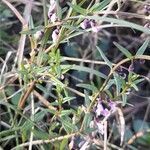Perennial herb, 0.15-0.30 m high; rhizomatous; stems slender, quadrangular, freely branched; sparingly pilose. Leaves petiolate, lanceolate, 10-30 x 3-6 mm, base obtuse to hastate, apex acute, margins entire, inrolled; glabrous, gland-dotted beneath. Inflorescence racemose; flowers solitary in axils of opposite leaves, verticils 2-flowered; pedicels 2-3 mm long. Flowers violet to red or white, purple-spotted. Calyx puberulous to hispidulous, 3 mm long in fruit. Corolla small; tube ascending, 3-4 mm long, widening at throat; lips 2, Sub-Equal, upper lip erect, concave or galeate; lower lip spreading. Stamens 4, didynamous, reaching apex of upper lip, lower pair attached to base of tube. Flowering time Oct.-Jan. Fruit an ovoid to subglobose nutlet.



